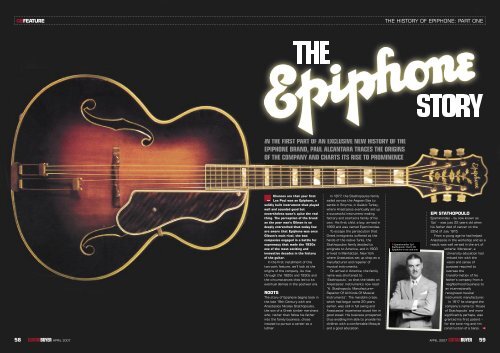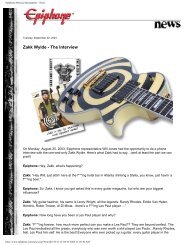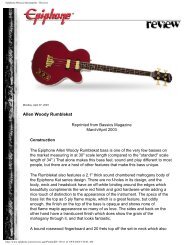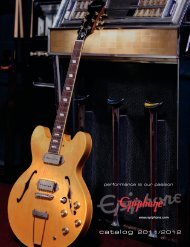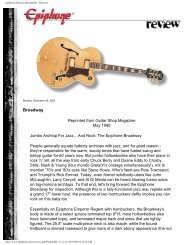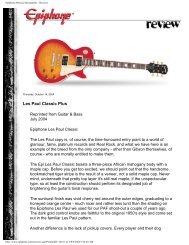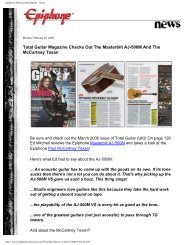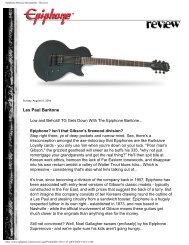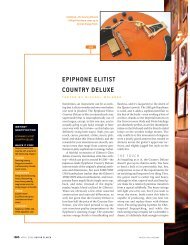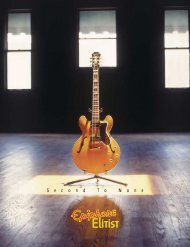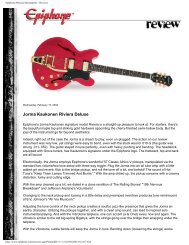IN THE FIRST PART OF AN EXCLUSIVE NEW HISTORY ... - Epiphone
IN THE FIRST PART OF AN EXCLUSIVE NEW HISTORY ... - Epiphone
IN THE FIRST PART OF AN EXCLUSIVE NEW HISTORY ... - Epiphone
You also want an ePaper? Increase the reach of your titles
YUMPU automatically turns print PDFs into web optimized ePapers that Google loves.
GBFEATURE<br />
<strong>THE</strong> <strong>HISTORY</strong> <strong>OF</strong> EPIPHONE: <strong>PART</strong> ONE<br />
<strong>THE</strong><br />
STORY<br />
<strong>IN</strong> <strong>THE</strong> <strong>FIRST</strong> <strong>PART</strong> <strong>OF</strong> <strong>AN</strong> <strong>EXCLUSIVE</strong> <strong>NEW</strong> <strong>HISTORY</strong> <strong>OF</strong> <strong>THE</strong><br />
EPIPHONE BR<strong>AN</strong>D, PAUL ALC<strong>AN</strong>TARA TRACES <strong>THE</strong> ORIG<strong>IN</strong>S<br />
<strong>OF</strong> <strong>THE</strong> COMP<strong>AN</strong>Y <strong>AN</strong>D CHARTS ITS RISE TO PROM<strong>IN</strong>ENCE<br />
Chances are that your first<br />
... Les Paul was an <strong>Epiphone</strong>, a<br />
solidly built instrument that played<br />
well and sounded good but<br />
nevertheless wasn’t quite the real<br />
thing. The perception of the brand<br />
as the poor man’s Gibson is so<br />
deeply entrenched that today few<br />
are aware that <strong>Epiphone</strong> was once<br />
Gibson’s main rival, the two<br />
companies engaged in a battle for<br />
supremacy that made the 1930s<br />
one of the most exciting and<br />
innovative decades in the history<br />
of the guitar.<br />
In the first installment of this<br />
two-part feature, we’ll look at the<br />
origins of the company, its rise<br />
through the 1920s and 1930s and<br />
the circumstances that led to its<br />
eventual demise in the postwar era.<br />
ROOTS<br />
The story of <strong>Epiphone</strong> begins back in<br />
the late 19th Century with one<br />
Anastasios Nicolas Stathopoulos,<br />
the son of a Greek timber merchant<br />
who, rather than follow his father<br />
into the family business, chose<br />
instead to pursue a career as a<br />
luthier.<br />
In 1877, the Stathopoulos family<br />
sailed across the Aegean Sea to<br />
settle in Smyrna, in Asiatic Turkey,<br />
where Anastasios eventually set up<br />
a successful instrument-making<br />
factory and started a family of his<br />
own. His first child, a boy, arrived in<br />
1893 and was named Epaminondas.<br />
To escape the persecution that<br />
Greek immigrants suffered at the<br />
hands of the native Turks, the<br />
Stathopoulos family decided to<br />
emigrate to America, and in 1903<br />
arrived in Manhattan, New York<br />
where Anastasios set up shop as a<br />
manufacturer and repairer of<br />
musical instruments.<br />
On arrival in America, the family<br />
name was shortened to<br />
‘Stathopoulo’, so that the labels on<br />
Anastasios’ instruments now read:<br />
“A. Stathopoulo, Manufacturer-<br />
Repairer Of All Kinds Of Musical<br />
Instruments”. The mandolin craze,<br />
which had begun some 20 years<br />
earlier, was still in full swing and<br />
Anastasios’ experience stood him in<br />
good stead. His business prospered,<br />
thus enabling him able to provide his<br />
children with a comfortable lifestyle<br />
and a good education.<br />
■ Epaminondas ‘Epi’<br />
Stathopoulo: that’s Mr<br />
<strong>Epiphone</strong> to me and you<br />
EPI STATHOPOULO<br />
Epaminondas – by now known as<br />
‘Epi’ – was just 22 years old when<br />
his father died of cancer on the<br />
22nd of July 1915.<br />
From a young age he had helped<br />
Anastasios in the workshop and as a<br />
result was well versed in the art of<br />
lutherie. Moreover, a<br />
University education had<br />
imbued him with the<br />
vision and sense of<br />
purpose required to<br />
oversee the<br />
transformation of his<br />
father’s company from a<br />
neighborhood business to<br />
an internationally<br />
recognised musical<br />
instrument manufacturer.<br />
In 1917 he changed the<br />
company’s name to ‘House<br />
of Stathopoulo’ and more<br />
significantly perhaps, was<br />
granted his first patent –<br />
for the tone ring and rim<br />
➔<br />
construction of a banjo.<br />
➔<br />
58 GUITARBUYER APRIL 2007<br />
APRIL 2007<br />
GUITARBUYER<br />
59
GBFEATURE<br />
<strong>THE</strong> <strong>HISTORY</strong> <strong>OF</strong> EPIPHONE: <strong>PART</strong> ONE<br />
JAZZ AGE<br />
The end of the First World War<br />
ushered in a colourful decade that is<br />
often referred to as the Roaring<br />
Twenties or the Jazz Age. Young<br />
women wearing bobbed hair and<br />
skirts that exposed their knees<br />
danced the Charleston and the Black<br />
Bottom to a new kind of music that<br />
outraged an older generation in<br />
much the same way that rock and<br />
roll would do some 40 years later.<br />
“The music is sensuous, the<br />
female is only half dressed and the<br />
motions may not be described in a<br />
family newspaper,” ranted the<br />
Catholic Telegraph, while The Ladies’<br />
Home Journal of August 1921 posed<br />
the question, “Does Jazz Put the<br />
Sin in Syncopation?” (to which one<br />
Mrs Marx E. Oberndorfer, of the<br />
General Federation of Women’s<br />
Clubs replied, “Such music has<br />
become an influence for evil!”).<br />
B<strong>AN</strong>JO BOOM<br />
America’s love affair with the dulcet<br />
tones of the mandolin was over and<br />
the instrument was set aside in<br />
favour of the tenor banjo, a shortscale<br />
instrument with four metal<br />
strings that, unlike the mandolin,<br />
could be heard above the din of<br />
massed saxophones, cornets and<br />
trombones. Moreover, the tenor<br />
banjo, like the mandolin, was tuned in<br />
fifths, a fact that allowed erstwhile<br />
mandolin players to switch to the<br />
new instrument with ease.<br />
Epi showed little compunction in<br />
abandoning the mandolin family<br />
instruments that his father had<br />
made. He intended to make a<br />
success of the family business, and<br />
if banjos were the up and coming<br />
thing then banjos were what the<br />
‘House of Stathopoulo’ was going to<br />
build!<br />
■ Epi’s first<br />
patent was for a<br />
banjo tone ring<br />
■ A 1920s ad for the<br />
House of Stathopulo’s<br />
<strong>Epiphone</strong> Recording<br />
Series banjo, featuring<br />
banjoist Frank Reino<br />
■ <strong>Epiphone</strong> launched<br />
their Recording<br />
Series guitars in 1928<br />
Introduced in the mid-1920s, the<br />
<strong>Epiphone</strong> Recording Series (named<br />
after Epi) initially comprised five<br />
high-quality models, the Recording,<br />
Artist, Bandmaster, Concert and De<br />
Luxe as well as a two budget<br />
models, the Professional and the<br />
Wonder.<br />
The line was an immediate<br />
success and, by the close of the<br />
decade, <strong>Epiphone</strong> had added several<br />
new models to its catalogue. Priced<br />
at $500 (around $5,700 in today’s<br />
money), the Emperor banjo was a<br />
fabulous concoction of pearloid and<br />
rhinestones that boasted an ebony<br />
neck with nine laminates of<br />
multicoloured wood, an ornately<br />
carved heel and engraved,<br />
gold-plated hardware.<br />
The <strong>Epiphone</strong> name was now<br />
better known than ‘House of<br />
Stathopoulo’ and as a result the<br />
company name was changed to<br />
‘<strong>Epiphone</strong> Banjo Corporation’ in<br />
1928.<br />
With a catalogue that presented<br />
a line of banjos matching the best<br />
offered by Paramount, B&D (Bacon<br />
And Day), Ludwig or Weymann, the<br />
future of the <strong>Epiphone</strong> Banjo<br />
Corporation must have appeared<br />
secure. Howver, with the Great<br />
Depression on the horizon and the<br />
Jazz Age drawing to a close, a<br />
threat to the banjo’s dominance<br />
was about to appear in the form<br />
of the humble six-string guitar.<br />
EDDIE’S ARCHTOP<br />
The banjo’s role in the jazz rhythm<br />
section might have continued<br />
unchallenged were it not for the<br />
influence of guitar virtuoso Eddie<br />
Lang. From the mid-1920s to his<br />
untimely death in 1933, Lang<br />
played and/or recorded with jazz<br />
greats such as King Oliver, Louis<br />
Armstrong, Bix Beiderbecke,<br />
Benny Goodman and the Dorsey<br />
Brothers, while his work with jazz<br />
fiddler Joe Venuti established<br />
the guitar/violin template<br />
that would later be<br />
exploited with great<br />
success by Django<br />
Reinhardt and Stephane<br />
Grappelli.<br />
Carl Kress, George<br />
Van Eps and Dick<br />
McDonough were<br />
but three of the<br />
banjo players who<br />
turned to the<br />
guitar after hearing<br />
Eddie, who<br />
■ A 1920s Recording<br />
Series guitar: these<br />
oddly shaped, round<br />
soundhole guitars<br />
were not a success<br />
■ Now that’s more<br />
like it: Epi nailed<br />
the archtop market<br />
with the Masterbilt<br />
Series, including<br />
this De Luxe<br />
incidentally had worked as a banjo<br />
player himself in the early 1920s.<br />
Eddie Lang’s choice of guitar<br />
– a Gibson L-5 – would prove as<br />
influential as his playing style.<br />
Launched in 1922 alongside the<br />
F-5 mandolin (the H-5 mandola was<br />
added a year later and the K-5<br />
mandocello in 1924), the L-5 was<br />
part of Gibson’s new Style 5<br />
Master Model Line, an attempt<br />
on the part of the company to<br />
revive the flagging fortunes of the<br />
mandolin orchestra (at the time<br />
Gibson regarded the guitar as a<br />
member of the mandolin family).<br />
Though this strategy would<br />
ultimately prove unsuccessful, the<br />
L-5 possessed sufficient volume,<br />
attack and ‘cutting power’ to hold<br />
its own amongst the horns and<br />
percussion that comprised the<br />
period’s dance bands.<br />
At 16 inches across at its<br />
widest point, with a carved top,<br />
14 frets clear of the body and<br />
violin style f-holes, the L-5<br />
embodied the future of<br />
the guitar. Seemingly<br />
unaware of what it had<br />
created, Gibson failed to<br />
capitalise on the<br />
model’s potential and<br />
for several years the<br />
L-5 remained the<br />
company’s only f-hole<br />
archtop.<br />
SIX-STR<strong>IN</strong>G RIVALS<br />
In 1928, at the height of the banjo<br />
boom, <strong>Epiphone</strong> introduced the<br />
Recording Series of guitars. Though<br />
the move demonstrated remarkable<br />
prescience on the part of Epi, the<br />
Recording Series was not a<br />
success. With their round<br />
soundholes, laminated backs and<br />
idiosyncratic body shapes, the<br />
guitars lacked the volume and<br />
projection that had made the Gibson<br />
L-5 the instrument of choice for<br />
dance band guitarists.<br />
Quick to acknowledge that it had<br />
misjudged the market, <strong>Epiphone</strong><br />
announced a new line of guitars in<br />
June 1931. This time the<br />
significance of the L-5 had not been<br />
lost on Epi and the introduction of<br />
the Masterbilt Series (a reference<br />
no doubt to Gibson’s Master Model<br />
instruments) marked the first of<br />
many attempts on <strong>Epiphone</strong>’s part<br />
to appropriate the Kalamazoo-based<br />
company’s crown.<br />
The Masterbilt line was topped by<br />
the maple-bodied De Luxe, which in<br />
terms of size and appointments was<br />
designed to surpass the L-5. To this<br />
end, the guitar measured 16.375<br />
inches across and featured ornate<br />
fingerboard inlays and a fancy<br />
headstock complete with three<br />
pearl banners engraved with<br />
‘<strong>Epiphone</strong>’, ‘De Luxe’ and<br />
‘Masterbilt’. Like the L-5 it boasted<br />
violin-style f-holes and a carved top<br />
and back.<br />
Other Masterbilt archtops ranged<br />
from the walnut-bodied Broadway –<br />
the same size as the Deluxe but not<br />
quite as fancy – to the 13-inch-wide<br />
Olympic, which had no binding or<br />
logo. Incidentally, the modern<br />
<strong>Epiphone</strong> company revived the<br />
Masterbilt name for a range of upmarket<br />
acoustic guitars, launched in<br />
2004. Appropriately, these new<br />
Masterbilts feature the pre-Gibson,<br />
script-style <strong>Epiphone</strong> logo.<br />
SUPER SIZE ME<br />
The original Masterbilt Series<br />
totaled 12 archtop models (including<br />
tenor guitars). <strong>Epiphone</strong> had thrown<br />
down the gauntlet and in 1934<br />
Gibson responded by ‘advancing’ all<br />
four of its 16-inch models to a 17-<br />
inch body width (between 1929 and<br />
1932 Gibson had added three new<br />
16-inch f-hole models to its line: the<br />
L-10, L-12 and L-7).<br />
If this wasn’t enough, the<br />
company unveiled its new secret<br />
weapon: the Super 400. Measuring<br />
a full 18 inches across its lower<br />
bout, Gibson’s new archtop was<br />
ostentatiously named for its price<br />
of $400 (around $6000 in today’s<br />
money). It was more expensive than<br />
any guitar that Gibson, or for that<br />
matter any of Gibson’s competitors,<br />
had offered to date.<br />
Not to be outdone, <strong>Epiphone</strong><br />
increased the size of the De Luxe,<br />
Broadway and Triumph by an inch,<br />
thereby maintaining a 0.375-inch<br />
advantage over their Gibson<br />
counterparts, and in 1935 hit back<br />
at the Super 400 with a still larger<br />
guitar, the 18.5-inch-wide Emperor,<br />
as pictured on the opening pages of<br />
this article. The name was chosen<br />
to capitalise on the furore caused<br />
by the Duke of Windsor renouncing<br />
the throne to marry an American).<br />
The model was promoted with a<br />
provocative advertising campaign<br />
that pictured the guitar cradled in<br />
the arms of a semi-clothed woman!<br />
EPIPHONE PLUGS <strong>IN</strong><br />
<strong>Epiphone</strong>’s first electric guitars<br />
were unveiled in 1935, briefly under<br />
the ‘Electraphone’ brand name, then<br />
later as the Electar Series. Just as<br />
the ‘Masterbilt’ name had sought to<br />
capitalise on Gibson’s Master Model<br />
line, ‘Electraphone’ and ‘Electar’<br />
alluded to the electric instruments<br />
introduced by the Electro String<br />
Company in 1932. That company’s<br />
brand name was changed to<br />
Rickenbacker in 1934.<br />
Early <strong>Epiphone</strong> electrics (1935 to<br />
1936) were fitted with a<br />
Rickenbacker-style horseshoe pickup<br />
with magnets that wrapped over<br />
the strings (to its credit, <strong>Epiphone</strong><br />
paid Rickenbacker<br />
royalties on its<br />
pickup patent). In<br />
1937 this unit<br />
was replaced with<br />
an oblong-shaped<br />
pickup that was<br />
fitted with a bar<br />
magnet. A<br />
variation, known as<br />
the ‘Truebalance’<br />
pickup, featured<br />
large slot-head<br />
polepieces (see the<br />
‘Patent Pickups’<br />
box on page 62).<br />
By 1936,<br />
<strong>Epiphone</strong> offered<br />
four Hawaiian<br />
models – the<br />
Electar Hawaiian<br />
(with a teardrop<br />
<strong>THE</strong> LES PAUL CONNECTION<br />
BEFORE GIBSON, LES WAS <strong>AN</strong> EPIPHONE M<strong>AN</strong><br />
■ An early champion of the<br />
solid body electric guitar,<br />
Les Paul built his famous<br />
‘Log’ – a 4x4-inch length of<br />
pine to which a guitar neck<br />
and body ‘wings’ from an<br />
<strong>Epiphone</strong> archtop were<br />
attached – at the <strong>Epiphone</strong><br />
factory in 1941.<br />
“The guys at <strong>Epiphone</strong> let me<br />
use the factory on Sundays,<br />
that’s where I built the Log,” Les<br />
recalled when we spoke to him<br />
last year (see issue 61 for the full<br />
interview). The function of the<br />
hollow body ‘wings’ was purely<br />
cosmetic: “It didn’t look like a<br />
guitar and when I played it at a<br />
nightclub, there was no response<br />
from the audience at all. So I<br />
went back to the factory, built<br />
‘wings’ and attached them to the<br />
Log in order to make it look<br />
more like a guitar. They were just<br />
props. I went back to the same<br />
nightclub, sat down and tore the<br />
place apart. Everybody loved it.<br />
I said, ‘My goodness, people hear<br />
with their eyes!’”<br />
Though some sources suggest<br />
that the Log was fitted with a<br />
Gibson neck, Les has stated that<br />
the neck, like the ‘wings’, were<br />
from an <strong>Epiphone</strong> guitar. Walter<br />
Carter, author of <strong>Epiphone</strong>: The<br />
Complete History (Hal Leonard,<br />
■ As this ad for the<br />
Emperor shows, using<br />
scantily clad females to<br />
flog guitars is nothing new<br />
ISBN 0-7935-4203-0) concurs:<br />
“(It was) a stock <strong>Epiphone</strong> neck,<br />
although Paul used a fingerboard<br />
made by the Chicago-based<br />
Larson Brothers. In the early<br />
1950s when Paul signed an<br />
endorsement agreement with<br />
Gibson, Gibson put a new veneer<br />
with a Gibson logo on the<br />
headstock of the Log.”<br />
During the 1940s Les used<br />
various other heavily modified<br />
<strong>Epiphone</strong> hollowbodies, like the<br />
one he’s pictured with above, the<br />
‘trapdoor’ at the back of the<br />
body making it easy to change<br />
the pickups and alter the<br />
electronics. ‘How High The<br />
Moon’, ‘Bye Bye Blues’ and<br />
numerous other hits were<br />
recorded using one of these<br />
guitars, which Les referred to<br />
as his ‘clunkers’.<br />
shaped body and single horseshoe<br />
pickup), the Electar Model M<br />
Hawaiian (with ‘stairstep’ body,<br />
metal top and single horshoe<br />
pickup), the Electar Model C<br />
Hawaiian (featuring a guitar-shaped<br />
body and oblong bar pickup) and the<br />
Tony Rocco signature model double<br />
neck (a rectangular body with angled<br />
corners, metal top and horseshoe<br />
pickups).<br />
The range of Electric Spanish<br />
models (regular hollowbody electric<br />
guitars) comprised the Electar<br />
Model M Spanish (a 14.75-inch-wide<br />
laminated maple body with a single<br />
horseshoe pickup) and the Electar<br />
Model C Spanish (with a 13.5-inchwide<br />
laminated maple body and a<br />
single blade pickup). An electric<br />
banjo with a sunburst finished<br />
maple top and single horseshoe<br />
pickup was available in both tenor<br />
and plectrum formats.<br />
Most of the <strong>Epiphone</strong> electric<br />
guitars built in the 1930s featured<br />
a ‘trapdoor’ arrangement on the<br />
back, complete with a detachable<br />
cloth-covered plate that provided<br />
easy access ➔ to the electronics. ➔<br />
60 GUITARBUYER APRIL 2007 APRIL 2007 GUITARBUYER 61
GBFEATURE<br />
<strong>THE</strong> <strong>HISTORY</strong> <strong>OF</strong> EPIPHONE: <strong>PART</strong> ONE<br />
EPIPHONE<br />
PATENT PICKUPS<br />
<strong>AN</strong>O<strong>THE</strong>R EPIPHONE <strong>FIRST</strong>: ADJUSTABLE<br />
POLEPIECES<br />
TIMEL<strong>IN</strong>E<br />
1877<br />
The Stathopoulos family moves to Smyrna<br />
in Asiatic Turkey where Anastasios<br />
Stathopoulos later establishes a successful<br />
instrument-making factory<br />
1893<br />
Epaminondas (later nicknamed Epi) is born<br />
1903<br />
In order to escape persecution by the Turks,<br />
Anastasios moves his family to New York<br />
City<br />
1915<br />
Anastasios dies, leaving Epi in charge<br />
1917<br />
Epi changes the company name to ‘House<br />
of Stathopoulo’ and is granted his first<br />
patent for the tone ring and rim<br />
construction of a banjo<br />
1924<br />
Epi registers the <strong>Epiphone</strong> brand name<br />
1925<br />
The <strong>Epiphone</strong> name appears on the<br />
company’s new <strong>Epiphone</strong> Recording Series<br />
banjos<br />
1928<br />
The House of Stathopoulo officially becomes<br />
the <strong>Epiphone</strong> Banjo Corporation. <strong>Epiphone</strong><br />
introduces the Recording Series guitars<br />
1931<br />
<strong>Epiphone</strong> introduces the Masterbilt line of<br />
f-hole archtop guitars<br />
1935<br />
The company name is changed to <strong>Epiphone</strong><br />
Inc; <strong>Epiphone</strong> introduces the 18.5-inch-wide<br />
Emperor; first electric guitars announced<br />
1937<br />
<strong>Epiphone</strong> introduces the Truebalance pickup<br />
with adjustable pole pieces, the first design<br />
of its kind<br />
1943<br />
Epi Stathopoulo dies aged 50, leaving<br />
brothers Orphie and Frixo in charge<br />
1948<br />
Following disagreements with Orphoe, Frixo<br />
sells his stock in the company<br />
1953<br />
Following strike action, the <strong>Epiphone</strong><br />
factory is moved from Manhattan to<br />
Philadelphia. Many of the company’s<br />
longtime employees choose to remain in<br />
New York and the quality of <strong>Epiphone</strong>’s<br />
products declines as a result<br />
■ <strong>Epiphone</strong> was the first company to<br />
introduce a pickup that featured<br />
adjustable polepieces.<br />
The unit that Gibson had fitted to its first<br />
‘Electric Spanish’ model, the ES-150 of 1936,<br />
featured a single blade that extended beneath the<br />
strings across the pickup’s upper surface (the<br />
‘blade’ was actually the visible end of a metal plate<br />
that protruded up through the pickup’s coil). In<br />
an attempt to counter uneven output, Gibson<br />
issued a second version in 1938 that featured a<br />
notch beneath the second string. Meanwhile,<br />
<strong>Epiphone</strong>’s Herb Sunshine came up with an<br />
alternative approach in the form of the<br />
‘Truebalance’ pickup that <strong>Epiphone</strong> introduced in<br />
1937. By positioning an adjustable pole-piece (a<br />
slot-head screw) beneath each string, the player<br />
could fine-tune the pickup’s output to<br />
complement the strings and amplifier used.<br />
END <strong>OF</strong> <strong>AN</strong> ERA<br />
As the 1930s drew to a close, the<br />
debonair Epi could look back on the<br />
decade with pride. <strong>Epiphone</strong> guitars were<br />
now seen in the hands of top players like<br />
Tony Mottola (George Hall Band), Dick<br />
McDonough (Benny Goodman) and<br />
George Van Eps (Ray Noble) and the<br />
company had matched the mighty Gibson<br />
blow for blow since the introduction of<br />
the Masterbilt models in 1931.<br />
Married to a glamorous ex-‘Ziegfeld<br />
Girl’ (these were the chorus girls from<br />
Florenz Ziegfeld’s Follies Bergeres-style<br />
theatre shows, many of whom went on<br />
to screen stardom), Epi could afford a<br />
lifestyle befitting the President of one of<br />
America’s most prestigious musical<br />
instrument manufacturers. Moreover,<br />
the competition between <strong>Epiphone</strong> and<br />
Gibson showed no indication of slowing<br />
down, and all signs suggested that the<br />
best was yet to come.<br />
POSTWAR UPHEAVAL<br />
■ This ad from December, 1936<br />
promotes one of <strong>Epiphone</strong>’s first<br />
electric instruments, the Electar<br />
Model C hawaiian guitar<br />
As things turned out, Epi died of leukemia<br />
on the 6th of June 1943, aged just 50.<br />
Responsibility for the company passed to<br />
his younger brothers, Orphie and Frixo,<br />
Orphie taking over as President, with<br />
Frixo as Vice President and Treasurer.<br />
By 1948 <strong>Epiphone</strong> was offering the<br />
Emperor and De Luxe with a cutaway, a<br />
feature that Gibson had introduced back<br />
in 1939 on the L-5 Premier and Super-<br />
400 Premier. Next, Gibson introduced<br />
the three-pickup ES-5 and <strong>Epiphone</strong><br />
responded with a three pickup guitar of<br />
its own, the Zephyr Emperor Regent.<br />
While the Gibson had three volume knobs<br />
and a master tone control, the <strong>Epiphone</strong><br />
boasted a bank of six push buttons plus<br />
the usual tone and volume knobs!<br />
The rivalry between the two companies<br />
had picked up from where it left off prior<br />
the war and ostensibly things continued<br />
as before. But behind the scenes all was<br />
not well. The Stathopoulo brothers fell<br />
out and in 1948 Frixo resigned, selling<br />
his share to Orphie. Then, in 1953,<br />
following a four-month strike at<br />
<strong>Epiphone</strong>’s New York plant, the <strong>Epiphone</strong><br />
factory was moved to Philadelphia. Many<br />
long-time employees refused to leave<br />
New York and as a result, the quality of<br />
<strong>Epiphone</strong>’s products suffered.<br />
After several failed attempts to go<br />
into business on his own, Frixo returned<br />
to New York. There was talk of the two<br />
brothers restarting <strong>Epiphone</strong> together<br />
but Frixo died in 1957 at the age of 52.<br />
Orphie, who by now had had enough,<br />
looked for a buyer for the company, but<br />
the reputation for quality and innovation<br />
that Epi had worked so hard to build had<br />
now been squandered. “(Their guitars)<br />
were so poor you couldn’t give them<br />
away,” commented Gibson’s General<br />
Manager, Ted McCarty.<br />
The future looks bleak, but in the<br />
second part of this feature we’ll discover<br />
how Gibson resurrected <strong>Epiphone</strong>. GB ➔<br />
62 GUITARBUYER APRIL 2007


